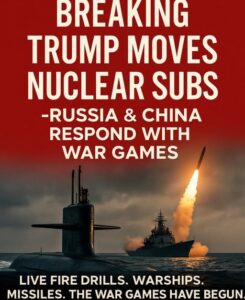BREAKING: Trump Deploys Nuclear Subs — Russia and China Respond With Missile Launches and Joint Drills

In a rapidly escalating global standoff, tensions in the Indo-Pacific reached a boiling point today after President Donald Trump authorized the deployment of nuclear-powered U.S. submarines into the region — a move that prompted immediate and aggressive military responses from both Russia and China.
Within hours, Russian naval forces fired cruise missiles from ships stationed in the Sea of Japan, while China launched live-fire exercises involving advanced destroyers near Taiwan. The timing and coordination left no doubt: these were not routine drills, but a deliberate counter-response to perceived U.S. provocation.
Simmering Tensions Go Hot
The Asia-Pacific region — already rife with territorial disputes and power plays — saw a dramatic escalation following reports that U.S. submarines had entered contested waters. Satellite imagery confirmed the presence of American vessels operating in proximity to both Chinese and Russian maritime zones.
In response, Russian forces initiated missile strikes during a previously unannounced naval exercise. Nearly simultaneously, Chinese warships began discharging live ammunition in sensitive areas east of Taiwan — an area long considered a red line by Beijing.
Observers and military analysts are calling this moment the most coordinated show of Russian-Chinese force in the Pacific since the Cold War era.
“This isn’t just about deterrence,” said one defense analyst. “It’s a message — and possibly a dress rehearsal for a broader conflict.”
Civilians Caught in the Crosshairs
The sudden military activity has triggered evacuations of civilian vessels, with fishing fleets in the Sea of Japan receiving urgent orders to vacate the area. Regional airspace is under tight military surveillance, and shipping routes are being redirected.
Real-time satellite data revealed synchronized missile launches and close-contact naval maneuvers between Russian and Chinese forces — a level of cooperation that U.S. officials had feared, but hoped to prevent.
White House Silent — For Now
As of this writing, the White House has not issued a formal statement. However, sources close to the administration suggest President Trump’s submarine deployment was intended as a show of strength — a warning shot to Beijing and Moscow as their strategic partnership deepens across the Indo-Pacific corridor.
Whether that gamble will stabilize the situation or ignite further conflict remains to be seen.

A New Global Flashpoint?
Diplomatic experts are now urging restraint, but behind closed doors, military officials are bracing for further escalations.
“This could tip the balance,” one intelligence insider told reporters. “If diplomacy doesn’t catch up to the firepower on display, we’re one mistake away from a historic confrontation.”
As the world watches closely, one thing is clear: today’s developments have the potential to reshape alliances, redraw red lines, and rewrite the rules of global power overnight.
Stay with us for continuous updates on this developing story.